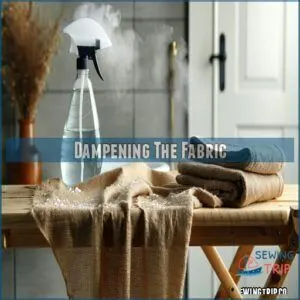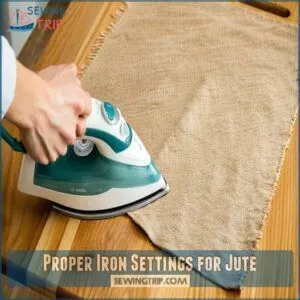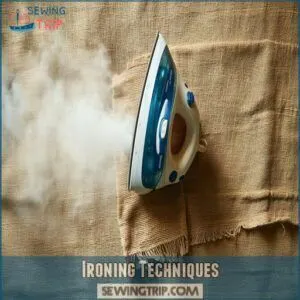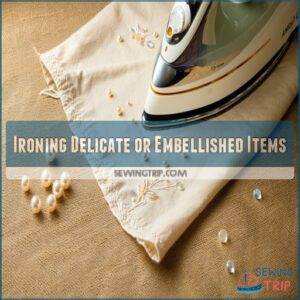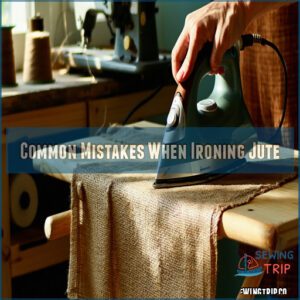This site is supported by our readers. We may earn a commission, at no cost to you, if you purchase through links.

Use low to medium heat to avoid scorching its natural fibers, and always place a pressing cloth (an old pillowcase works great) between the iron and the fabric.
Test on a hidden corner first, just in case it acts temperamental.
Slightly dampening the fabric beforehand or using a steam iron can help with stubborn wrinkles, but go easy—jute isn’t a fan of too much moisture and might shrink.
For an extra-safe option, try steaming instead of ironing.
Curious about other tricks to keep jute wrinkle-free? Stay tuned!
Table Of Contents
- Key Takeaways
- What is Jute Fabric
- Is Jute Fabric Ironable
- Preparing Jute for Ironing
- Proper Iron Settings for Jute
- Ironing Jute Fabric Safely
- Alternative Methods for Removing Wrinkles
- Caring for Jute After Ironing
- Common Mistakes When Ironing Jute
- Specialized Care for Jute Fabric
- Preventing Wrinkles in Jute Fabric
- Frequently Asked Questions (FAQs)
- Conclusion
Key Takeaways
- Use low to medium heat when ironing jute and always place a pressing cloth between the iron and fabric to protect the natural fibers.
- Slightly dampen the fabric or use steam to tackle wrinkles, but avoid excess moisture to prevent shrinking.
- Always test on a hidden spot to ensure the heat setting won’t scorch or damage the fabric.
- For a safer alternative, use a garment steamer or hang the jute in a humid environment to naturally release wrinkles.
What is Jute Fabric
Jute fabric, often called burlap or hessian, is a strong, natural fiber made from plants.
It’s loved for its durability, eco-friendliness, and unique golden color, making it a favorite for everything from sacks to home decor.
Properties of Jute
Jute fabric, known as the "golden fiber," is a powerhouse of eco benefits.
This natural fiber stands out for its jute strength and biodegradable features, making it both durable and planet-friendly.
Its natural texture has a charming rustic vibe and is breathable, perfect for hot weather.
Here’s why jute impresses:
- Eco-Friendly – It’s sustainable and breaks down naturally.
- Tough Yet Stylish – Its strength withstands wear with flair.
- Breathable – Keeps you cool, no sweat.
- Versatile – From bags to jute fiber art, it’s everywhere.
With proper jute textile care, even ironing jute becomes stress-free!
Common Uses
It’s amazing how many places jute fabric pops up! It’s a favorite in homes, wardrobes, and even industries.
Here’s where it shines:
- Jute Bags: Tough, reusable, and stylish – perfect for groceries or your eco-friendly lifestyle.
- Home Decor: Think rustic table runners, burlap lampshades, or jute curtains (pro tip: ironing jute keeps those curtains looking sharp).
- Fashion Trends: Jute’s raw texture adds flair to casual wear and chic traditional outfits.
- Eco Products: In the textile industry, it’s a go-to for sustainable packaging, sacks, and gift wraps.
With the right fabric ironing guide, proper care, and ironing jute tips, these uses stay beautiful longer!
Is Jute Fabric Ironable
Thinking about taming those stubborn wrinkles on your jute fabric? Good news—you can!
Ironing jute fabric works, but it’s all about patience and care. Use low heat to avoid scorching, and always lay a damp cloth between your iron and the fabric for protection.
These jute ironing tips help preserve its natural texture. If full-on ironing feels risky, steaming jute fabric is a safe alternative.
With these simple moves, your burlap tablecloths or curtains will stay smooth, crisp, and totally wrinkle-free. Jute Fabric Care made easy!
Preparing Jute for Ironing
Before you start ironing jute, make sure it’s clean to avoid setting dirt or stains into the fibers.
Lightly dampen the fabric afterward to make smoothing out wrinkles easier and safer.
Cleaning The Fabric
Before ironing jute fabric, give it a good clean to tackle dirt and stains.
Here’s how to do it right:
- Spot-Clean Stains: Use a soft brush and a gentle detergent to lift fabric stains without harming the natural fibers.
- Hand-Wash with Care: Avoid water damage by keeping the wash quick and gentle. Machine washing? Don’t risk it.
- Air Dry Only: Skip the dryer. Instead, hang your fabric outside or on a line to let it dry naturally, wrinkle-free.
For tough stains, consider using a jute fabric cleaner to gently remove dirt.
Your jute’s clean and ready for ironing!
Dampening The Fabric
Before tackling those stubborn wrinkles, you’ll need the right fabric moisture level for your jute.
Here’s a quick guide to dampening methods that work:
| Method | Technique | Results |
|---|---|---|
| Spray Bottle | Light misting with lukewarm water | Even humidity control |
| Damp Cloth | Place between iron and fabric | Better steam application |
| Natural Steam | Hang in bathroom during shower | Gentle water absorption |
For best results when ironing natural fibers like jute, aim for slightly damp, never soaked, think morning dew rather than rainstorm.
Place a damp cloth between your iron and the fabric for extra protection during fabric smoothing methods, this technique gives you the perfect balance for steam ironing success.
Proper Iron Settings for Jute
You’ll want to set your iron to low or medium heat when tackling those stubborn wrinkles in jute fabric, just as you’d with other natural fibers.
For the best results, you’ll need a pressing cloth between the iron and fabric, since direct heat can damage jute’s delicate fibers.
Temperature Recommendations
Getting on top of your heat settings starts with understanding your fabric’s thermal limits.
For jute, stick to a medium-low iron temperature between 225°F to 300°F.
For other fabrics, consult this safe ironing temperature guide.
- Set your dial to low heat (225°F) and gradually increase if needed
- Test a hidden spot first—you’ll know the right temp when wrinkles smooth without scorching
- Keep a pressing cloth between the iron and jute for an extra safety buffer
Pro tip: Your iron settings matter more than you think.
Perfect temp equals perfect results.
Steam Vs. Dry Heat
Now that you’ve got your heat settings dialed in, let’s talk steam vs dry heat.
Your choice makes all the difference for those stubborn dry wrinkles.
Here’s what works best for ironing natural textiles like jute:
- Steam function relaxes fibers gently, making wrinkles surrender faster
- Dry heat offers more thermal control but needs extra moisture
- Low heat settings work with either method – just keep fabric damage in check
Understanding the steam iron benefits can help you make an informed decision for your ironing needs.
You’re the boss of those wrinkles!
Using a Pressing Cloth
A pressing cloth isn’t just another ironing tool – it’s your jute fabric’s best friend.
Place this protective layer between your iron and natural fibers to prevent scorching and protect delicate weaves.
For best heat resistance, pick cotton or linen cloth materials, matching the size of your jute piece.
When ironing jute with steam, these fabric layers distribute heat evenly and stop those dreaded shiny spots from ruining your textile projects.
Using an ironing pressing cloth can substantially enhance the ironing process for jute fabrics.
Ironing Jute Fabric Safely
You’ll want to iron your jute fabric with a gentle touch, just like you’d handle your favorite vintage scarf that’s been passed down through generations.
While it might seem tricky at first, you can easily smooth out those stubborn wrinkles by following some simple safety steps that’ll keep your jute looking fresh without damaging its natural fibers.
Ironing Techniques
To smooth wrinkles from jute, handle the iron like a pro.
Use slow, even strokes to avoid mishaps and keep tension light to prevent new creases.
A steam iron works wonders, but make sure the heat’s low and steady for fabric protection.
Glide with purpose for wrinkle removal without stress.
- Don’t rush it. Slow wins.
- Light pressure saves. No squishing.
- Heat’s tricky. Stay low.
- Ironing tools matter. Pick steam.
Avoiding Scorching or Burning
Scorched jute? Nobody wants that! Avoid it with these heat control methods:
- Stick to the low heat setting—jute’s thermal limits are low.
- Protect your fabric with a damp pressing cloth for scorching prevention.
- Always test iron settings on a hidden patch first—no ugly surprises later.
- Move your iron along the grain of the fibers—it’s like combing your hair!
Understanding the best iron settings is essential for safe and effective ironing of various fabrics, including jute.
Ironing Delicate or Embellished Items
When handling delicate fibers like jute, embellished item handling needs extra care.
Keep a pressing cloth handy to shield embroidery, beads, or sequins—it’s your fabric’s best friend.
Use low heat, brief strokes, and never linger in one spot for too long.
For vinyl letters, slip a cloth between the iron and vinyl to avoid a sticky mess.
Alternative Methods for Removing Wrinkles
You don’t always need an iron to tackle wrinkles in jute fabric—there are plenty of easy alternatives.
From steaming to hanging in a damp bathroom, these tricks can help smooth things out without risking damage.
Steaming Jute Fabric
Using a steam iron to smooth out jute fabric is easy if you follow the right steaming tips.
Switch on the steam function and hold the iron about half an inch away, letting the steam relax those deep jute wrinkles.
Always place a damp cloth between the iron and fabric to protect the natural fibers.
Think of it as gentle cleaning for your burlap!
Hanging to Release Wrinkles
Sometimes, the simplest trick works best—try hanging your jute fabric to ditch wrinkles.
Gravity will handle the creases, especially with some moisture in the air.
Here’s how to maximize this method:
- Give it time: Wrinkles ease up the longer it hangs.
- Play with humidity: A lightly humid room speeds things up.
- Leverage weight: Heavier jute smooths itself out over time.
Using Weights or a Garment Steamer
Stuck with stubborn wrinkles? Weighted smoothing might save the day.
Lay your jute flat, place weights like books along the wrinkles, and let fabric relaxation do the work.
Want more precision? Try garment steaming.
Adjust your steamer settings for jute, using gentle strokes to avoid damage.
These ironing techniques beat a clunky steam iron for safer wrinkle removal.
For best results, consider using a device with proper steam output control to gently remove wrinkles without damaging the fabric, which is a key part of fabric care.
Caring for Jute After Ironing
After ironing jute, you’ve got to handle it carefully to keep it looking neat and lasting longer.
Store it flat or loosely folded in a cool, dry spot to avoid new wrinkles and unwanted creases, which can be considered a complete concept for maintaining the item.
Proper Storage
A little effort in proper storage goes a long way in keeping your jute wrinkle-free and fabulous.
After ironing, follow these tips to guarantee fabric preservation:
- Use airtight containers for climate control and to protect against moisture or pests.
- Practice folded storage carefully to reduce creases without breaking fibers.
- Keep fabrics away from direct sunlight—it’s a culprit for fading!
By using the right storage materials and managing humidity levels, you’ll extend the shelf life of your jute.
Proper storage isn’t fussy, it’s smart textile care!
Maintaining Shape
Keeping your jute fabric’s shape is all about gentle handling and smart storage.
Use simple fold techniques to avoid deep creases, and for larger pieces, hanging works wonders for shape retention.
Be careful with heavy items that could cause fabric stretching – treat your jute like a delicate scarf, not a gym towel.
For long-term jute fabric maintenance, avoid stuffing it into tight spaces.
A little bit of crease management here and there guarantees smooth results the next time you’re ironing natural fibers.
Preventing Wrinkles
Wrinkles ruining your fabric relaxation goals?
Keep jute smooth with crease control strategies like folding gently and storing flat or hanging in a cool, dry space.
For extra wrinkle prevention, apply a light fabric treatment post-ironing jute fabric.
Regular checks help with texture preservation, avoiding tough wrinkles later.
Smooth finishing starts with thoughtful storage—skip the crumple chaos and embrace wrinkle-free charm!
Common Mistakes When Ironing Jute
Ironing jute might sound simple, but it’s easy to slip up and damage the fabric if you’re not careful.
Skipping steps like using a pressing cloth or testing a small spot first can quickly turn smooth wrinkles into a scorched mess.
Using Excessive Heat
Cranking the iron to a high heat setting might seem like a shortcut, but it’s more like playing with fire—literally.
Excessive heat causes Fabric Scorching, weakens fibers, and can shrink jute, leaving you with damage you can’t undo.
Burn Prevention starts with respecting jute’s Thermal Limits.
Here’s how to keep ironing jute safe:
- Stick to low Heat Settings—no exceptions.
- Skip the steam blast unless you’re sure it’s safe.
- Double-check fabric care tags—instructions can save the day.
Heat Damage Control is all about patience over panic.
Not Using a Pressing Cloth
Skipping a pressing cloth when ironing jute fabric is like dancing barefoot on hot coals—risky business.
A cloth adds a buffer, protecting against fabric damage and scorch prevention by diffusing heat evenly.
Using a pressing cloth product can substantially reduce the risk of ironing mistakes and fabric damage.
| Here’s a quick comparison: | Without Pressing Cloth | With Pressing Cloth |
|---|---|---|
| High burn risk | Low scorch risk | |
| Fabric weakens from heat | Heat settings protected | |
| Wrinkles burn into fibers | Smooth, safe results | |
| Frequent ironing mistakes | Controlled, safe process |
No pressing cloth? Try a pillowcase!
Not Testing a Small Area First
Rushing to iron jute without a test run? Big mistake! Avoid costly slip-ups by catching issues early.
- Test a hidden area: Check for shrinkage or discoloration before committing.
- Tweak iron temperature: Avoid heat setting errors that can scorch.
- Evaluate results: Spot signs of fabric damage, ensuring jute fiber protection.
This quick precaution saves you from fabric damage headaches!
Specialized Care for Jute Fabric
When jute fabric needs extra care, specialized options like dry cleaning and restoration services can work wonders.
They’ll help you keep your jute looking fresh and avoid accidental damage at home.
Dry Cleaning
If stains won’t budge or water’s a risk, dry cleaning has your back! It’s all about Solvent Options and Dry Methods to protect the fabric.
Professional services offer specialized Stain Removal and Cleaning Solutions, keeping your jute items safe.
When dealing with delicate materials like jute, understanding delicate fabric care is essential for maintaining their quality and appearance.
| Benefit | Description |
|---|---|
| Fabric Protection | Prevents water-related damage |
| Stain Removal | Tackles tough marks easily |
| Dry Methods | Avoids fabric browning |
| Professional Care | Expert handling guaranteed |
Specialized Fabric Services
Feeling overwhelmed with creases or stains? That’s where specialized fabric services come to the rescue.
These experts provide everything from fabric restoration to custom tailoring for your jute fabric. Think professional-grade care: stain removal, repairs, and even fabric finishing that leaves your textiles looking flawless.
- Fabric restoration for fixing wear and tear.
- Textile consulting for personalized care tips.
- Custom tailoring to enhance functionality.
- Professional alterations to adjust sizing perfectly.
Professional Cleaning and Restoration
When stains, damage, or stubborn wrinkles refuse to budge, professional cleaning is your secret weapon.
Experts specialize in fabric restoration, conservation methods, and textile repair for jute fabric. Think of it as giving your jute VIP treatment.
- Preserve its lifespan with expert cleaning solutions.
- Restore damaged or frayed edges perfectly.
- Boost its elegance with precise stain removal.
- Protect with proper textile maintenance.
Preventing Wrinkles in Jute Fabric
If you want to keep your jute fabric looking fresh, it all starts with proper handling and smart storage.
Don’t skip regular maintenance—it’s the secret to avoiding those stubborn wrinkles before they even start, and this can be considered a key step in proper handling.
Proper Handling
To keep jute fabric wrinkle-free, focus on Fabric Folding, Gentle Cleaning, and Moisture Control:
- Always fold along natural lines to avoid creases.
- Handwash with cold water and mild detergent for Gentle Cleaning without damaging the fibers.
- Air-dry flat to maintain shape and prevent shrinkage.
Master these steps, and you’ll ace Wrinkle Prevention with zero guesswork!
Storage Solutions
To make life easier, store your jute in fabric storage bags or airtight containers to prevent creases and extend its shelf life.
Consider folded storage or closet organizers if space is tight.
For long pieces, hanging racks or garment bags work wonders.
Keep it cool, dry, and mold-free. Proper textile preservation makes ironing a rare chore, trust me!
Regular Maintenance and Care
In the case of jute fabric care, the secret’s in the little things.
Regular maintenance keeps wrinkles away and your fabric looking fresh.
- Fabric inspection: Check periodically for dirt or damage.
- Gentle cleaning: Spot clean spills fast and avoid harsh chemicals.
- Humidity control: Store in a cool, dry place to prevent musty odors.
- Fabric revitalization: Air it out occasionally or use a garment steamer for quick touch-ups.
Always fold neatly—don’t just toss it somewhere—and handle it with care.
Stay consistent, and your jute will stay stunning and wrinkle-free.
Frequently Asked Questions (FAQs)
Can jute sacks be ironed?
Picture a wrinkled, stubborn jute sack—yes, you can iron it, but stick to low heat, use a pressing cloth, and dampen lightly.
Too much heat? It’s game over for that sack!
Can jute burlap sacks be ironed?
You can iron burlap sacks, but keep the heat low and always use a pressing cloth to protect the fabric.
Dampening it slightly helps with wrinkles, but don’t overdo it—jute hates too much moisture!
Can jute fabric be made in white?
Yes, jute fabric can be made white through bleaching, but it’s tricky.
Bleaching weakens the fibers, so it’s not great for heavy-duty use.
If you’re after a lighter look, consider dyeing options instead.
How to clean jute fabric?
Did you know jute can unravel faster than your plans sometimes?
Gently handwash it, use mild detergent, and air dry it flat.
Spot clean stains carefully, and always keep it away from sunlight or excess moisture.
Why is jute a good fabric?
It’s strong and durable, and eco-friendly—perfect if you’re tired of synthetic stuff.
It breathes, keeps its natural charm, and completely breaks down over time.
Plus, it’s versatile enough for sacks, home décor, or even trendy fashion.
Can jute fiber be blended with cotton?
They say opposites attract, and blending jute with cotton proves it.
Combining jute’s strength and eco-friendliness with cotton’s softness creates versatile, durable fabrics.
You’ll find them in decor, clothing, and even totes—practical and stylish!
How do you get wrinkles out of jute?
Toss your jute into a steamy bathroom or use a garment steamer for tricky wrinkles.
If you must iron, go low heat, cover with a clean cloth, and press gently—no scorch marks allowed!
Can you iron on a jute bag?
Around 80% of jute bags are reusable.
Use low heat, a pressing cloth, and avoid logos or prints when ironing one.
Steam helps, but test a small spot first to dodge mishaps.
Can hessian be ironed?
Hessian can be ironed, but be cautious.
Use a medium heat setting and always lay a pressing cloth on top to protect the fibers.
Test a small section first—nobody likes accidental scorch marks!
How do you soften jute fabric?
Give your jute fabric a gentle soak in lukewarm water with a bit of fabric softener.
After rinsing, stretch it slightly and air-dry.
For extra softness, lightly steam it while it’s still damp.
Conclusion
They say, "An ounce of prevention is worth a pound of cure," and that’s true for caring for jute fabric too.
Yes, you can iron jute fabric, but being gentle is key.
Stick to low to medium heat, use a pressing cloth, and test a small section first.
If ironing feels risky, steaming or careful hanging works wonders.
Handle jute with care, and it’ll stay smooth, sturdy, and wrinkle-free for the long haul.




